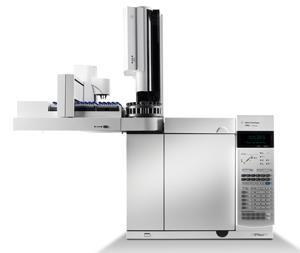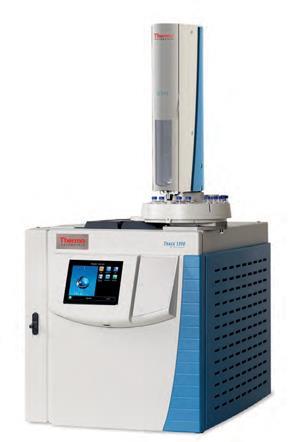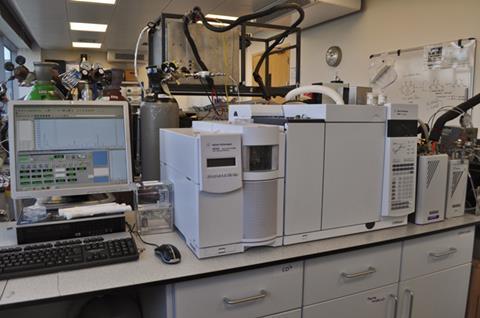How do you decide what gas chromatograph is right for your lab? Elisabeth Jeffries looks at what’s on the market

Gas chromatography (GC) is one of the most important tools in the chemical industry and in chemical laboratories. It is a technique that allows chemists to separate and analyse compounds that can be vaporised without decomposing. Analytical chemists use it for a wide variety of purposes, from forensic research to environmental testing, health screening and pharmaceuticals production. They use it in a wide range of activities, including testing the purity of a substance, separating the components of a mixture, purifying compounds and even determining constants such as the heat of a solution.
GC consists of a mobile phase and a stationary phase. The mobile phase is a carrier gas such as helium or nitrogen. The stationary phase includes a microscopic layer of liquid or polymer on an inert solid support, inside a piece of glass or metal tubing called a column. The test mixture is inserted into a stream of the inert gas. Liquid samples are vaporised beforehand. Gaseous compounds interact with the walls of the column, which is coated with the stationary phase, and this allows separation and extraction to take place. Each compound emerges from the column at a different time and this is known as the retention time. The difference in these retention times is what gives GC its analytical usefulness.
GC was first developed over a century ago, but became widespread after the second world war. Although it is now a very common technique, only a few manufacturers dominate the technology. These include Agilent, Shimadzu and Thermo Fisher. More specialised producers include Markes International and Spark Holland. Few market studies exist, but Agilent, based in California, US, is considered to be the largest producer in the world and has been operating in the market for 40 years.
The market is well-established, and innovation tends to be incremental. Lucy Carpenter, a professor of atmospheric chemistry at the University of York, UK, considers GC a very stable technology. ‘There hasn’t been much change in the last 10–20 years. It’s become more reliable but what it does hasn’t changed,’ she states. There is, however, one noticeable trend, which is increasingly to combine GC with mass spectrometry (MS) instrumentation. This is the analytical technique that measures the mass-to-charge ratio of charged particles used to determine the chemical structures of molecules.
Agilent
Manufacturers position their products carefully into the market, and are gradually introducing innovations adapted to modern requirements. Market leader Agilent says its 7890A Gas Chromatograph, one of several GC instruments made by the company, has ‘advanced separation capabilities, powerful new productivity features and real-time self-monitoring instrument intelligence’.
High sensitivity, speed and flexibility are important
Juan-Luis Aybar, a marketing manager for Agilent’s GC business, says the company is ‘present in all major industries worldwide: food, environmental, forensics and toxicology, energy and chemical’. They offer advanced pneumatics control and digital electronics, which the company says makes the machine more precise. Other features include an oven that cools down more quickly, and faster GC-MS oven ramps where the GC is used with mass spectrometry. This, Aybar suggests, helps improve speed, productivity and efficiency. ‘The combination of precise pneumatics, GC column oven temperature control and Agilent J&W GC columns leads to outstanding retention time repeatability,’ he says.
Shimadzu
Japanese company Shimadzu, which has subsidiaries all over the world, also produces a range of GC and GC-MS products. A global organisation employing 10,000 people (also working in other fields such as medical devices and aerospace) it sells into a wide range of markets, including hospitals, pharmaceuticals, petrochemical, flavour and fragrance, forensic research and environmental testing.

‘The instruments we manufacture and sell have to be easy to use in terms of hardware and software, but also sensitive, robust and reliable to cope with the many demanding fields we place them into,’ says Ian Parry, GC and GC-MS business manager in the UK. ‘We pride ourselves on tailoring each instrument to suit the customers need; in effect we provide them with a solution to their analyses, not just a box which can generate a result.’
The company produces both GC stand-alone instrumentation and GC-MS technology. Shimadzu markets the GC2010 plus for use with MS instruments. However, Parry emphasises that ‘on its own it has the most sensitive flame ionisation detector [FID] on the market and is extremely versatile’. Flame ionisation is one of the most effective ways to detect organic compounds. The sensitivity and versatility of the product, explains Parry, is due to the variety of accessories (such as injectors and detectors) that can be added on to it. ‘It can also be fitted as a true dual line system, with dual simultaneous injection to allow the user twice the throughput in the same amount of time,’ he explains.
Thermo Fisher

Thermo Fisher, based in Austin, Texas, also has a strong line in stand-alone GC and GC-MS. The company has launched a new GC this year: the TRACE 1300 series. Jason Cole, GC-MS product manager at Thermo Fisher Scientific, draws attention to its benefits and also particularly emphasises versatility. ‘The headline feature of the TRACE 1300 Series is its modular design. With GCs you have several different types of injectors and detectors,’ Cole says. ‘The TRACE 1300 Series is designed to be able to switch between different detectors and injectors similarly to removing and attaching Lego blocks. This means that people need to buy fewer GCs to get the same capabilities, since their GC can be quickly and easily customised for different applications,’ he adds.
The advantage of this modularity, he explains, is that it allows customers ‘to easily upgrade to new techniques and take advantage of new modules we develop in the future. GC applications are very diverse … since there are many different detector types you can use with the GC. So the modular design is particularly useful for those laboratories with a diverse set of application needs,’ he says.
What scientists want
All the manufacturers pay particular attention to a range of benefits that they all see as key customer concerns. These include both customised and versatile approaches, as well as easy updating. Agilent’s specialists go to the customer’s site after an instrument has been installed ‘to help them optimise the system, but also support the systems for their lifetime, helping the customer to reconfigure the systems if applications change and providing further training should staff change’, says Aybar.
High sensitivity and speed are benefits they see as equally important. Easy use and flexibility are also perceived advantages which they aim to provide to customers, such as the ability to switch from oven heating to cooling within three or four minutes. Shimadzu’s customised approach is particularly important, according to Parry, though he points out that many of the company’s customers also use Shimadzu’s instruments for many applications within one laboratory.
However, medical diagnosis is an example of a specialist field Shimadzu is involved in, for which it provides specialised GC. In particular, GC is used to screen the urine of new-born babies for a number of markers that could indicate a pre-existing genetic condition that can be watched for by clinicians. ‘Our instrument has a number of features for this – including inert source design, meaning the instrument can analyse more samples between needing to be cleaned. It also benefits from auto-annotation software designed to help biomedical scientists spend less time annotating peaks following successful processing of results,’ says Parry. Acids are extracted from the urine and converted to a dried derivative, which is then prepared for use in GC testing.
Speed, efficiency, versatility and of course cost are all differentiators that have distinguished one supplier from another so far. There have been many improvements over the decades, as Parry observes. ‘Where once upon a time a laboratory would have one GC for one application and there would be ten GCs, there are now two GCs fitted with dual lines, with multiple detectors,’ he says. ‘Companies have streamlined their capital instrumentation purchasing into multifaceted systems capable of the work of three or four individual machines due to money, but also to bench space as laboratories become more expensive to set up and run.’
Shrinking footprints
Size and portability are all pressures on the industry as applications develop or demand increases. Shimadzu prides itself on these aspects. ‘We have responded by looking at the footprint our GC and GC-MS offer, and making them as compact as possible, whilst still retaining their versatility and functionality. The GC2025 we have just released is our smallest footprint GC – measuring just 40cm × 42cm, meaning more laboratory space can be saved compared to other manufacturer instruments,’ says Parry.
Another feature he considers important is energy efficiency. ‘The GC2025 is also part of our eco range of GCs designed to use less power and gases than others on the market; whilst this is great for reducing a company’s carbon footprint, it also saves a lot of money on power and gas supplies,’ says Parry. This may, of course, become a growing demand as energy efficiency regulations become stricter.

Certainly a compact GC instrument is a concern for Carpenter, especially if it can combine robust performance with sensitivity. This is because much of her research involves outdoor tests in difficult environments such as the Arctic circle. ‘Atmospheric science is mostly in the field. You need to be able to take GCs everywhere – in an aircraft or on a ship for example – and to challenging locations. They have to survive vibrations. Humidity in the sample is always a massive problem as water doesn’t mix well,’ she explains. This is distinct from laboratory use typical in forensic or corporate environments. According to Carpenter, ease of use has improved over the last 20 years, but GC could still benefit from better portability, lower power consumption and compactness.
The future
Solutions are coming forward, some of them advanced by the York team itself. ‘There’s much more research on miniaturisation of the technology so that you can take a smaller, half-sized GC and take it on board a balloon or aircraft. But it hasn’t come to market yet,’ says Carpenter. When taking a sample, the scientist traps gases which are then thermally desorbed and transferred to the column. There is still a need to improve this process if GC is to become even more user-friendly.
There’s much more research on miniaturisation so you can take a GC on board a balloon or aircraft
‘There are subtleties to the way this is done and how cleanly it is carried over; this affects the quality of the chromatography. The size of the trap affects this – ideally it’s a small trap and a fast desorption process,’ she explains. Researchers in other fields could benefit from this, of course. Forensic scientists, such as those carrying out alcohol or drugs tests, often carry out their tests in the lab. Taking the lab outdoors might be quicker, more efficient and perhaps cheaper and also help develop the range of applications for GC-MS. As far as Carpenter’s own work is concerned, she observes that ‘Agilent is the most commonly encountered in the field’.
Nigel Manning, a principal clinical scientist at Sheffield Childrens’ Hospital in the UK, is one of Shimadzu’s customers. Manning considers that GC has greatly improved over the years, especially since computerised scanning came in during the 1980s, but has changed little since in terms of its configuration. Manning views most GC producers as reliable and keeps the GCs for 10 years or more given public sector budget limits. There have been, and continue to be, improvements in speed and testing cycles. ‘Developments in GC include faster run times and scanning. Shimadzu is well known for increasing run times through very narrow column bores,’ he states.
But Manning suggests GC is rarely used on its own nowadays. ‘Everyone has MS on the end of their GC now; it gives identification in a hard and fast way using the retention characteristics,’ he says. ‘What’s changing is not the GC itself but the MS that’s moving apace … there are probably improvements to be made to GC but apart from that, new MS approaches will make things quick to run and produce a higher throughput,’ he observes.
Elisabeth Jeffries is a science writer based in London, UK












No comments yet